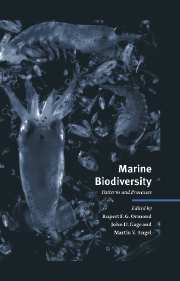Book contents
- Frontmatter
- Contents
- List of contributors
- Foreword: The value of diversity
- 1 Marine biodiversity in its global context
- 2 Gradients in marine biodiversity
- 3 Pelagic biodiversity
- 4 Biological diversity in oceanic macrozooplankton: More than counting species
- 5 Large-scale patterns of species diversity in the deep-sea benthos
- 6 Diversity, latitude and time: Patterns in the shallow sea
- 7 High benthic species diversity in deep-sea sediments: The importance of hydrodynamics
- 8 Diversity and structure of tropical Indo-Pacific benthic communities: Relation to regimes of nutrient input
- 9 Why are coral reef communities so diverse?
- 10 The biodiversity of coral reef fishes
- 11 The historical component of marine taxonomic diversity gradients
- 12 Population genetics and demography of marine species
- 13 Discovering unrecognised diversity among marine molluscs
- 14 Ecosystem function at low biodiversity – the Baltic example
- 15 Land–seascape diversity of the USA East Coast coastal zone with particular reference to estuaries
- 16 The development of mariculture and its implications for biodiversity
- 17 Protecting marine biodiversity and integrated coastal zone management
- 18 Conserving biodiversity in North-East Atlantic marine ecosystems
- Author index
- Species index
- Subject index
12 - Population genetics and demography of marine species
Published online by Cambridge University Press: 04 August 2010
- Frontmatter
- Contents
- List of contributors
- Foreword: The value of diversity
- 1 Marine biodiversity in its global context
- 2 Gradients in marine biodiversity
- 3 Pelagic biodiversity
- 4 Biological diversity in oceanic macrozooplankton: More than counting species
- 5 Large-scale patterns of species diversity in the deep-sea benthos
- 6 Diversity, latitude and time: Patterns in the shallow sea
- 7 High benthic species diversity in deep-sea sediments: The importance of hydrodynamics
- 8 Diversity and structure of tropical Indo-Pacific benthic communities: Relation to regimes of nutrient input
- 9 Why are coral reef communities so diverse?
- 10 The biodiversity of coral reef fishes
- 11 The historical component of marine taxonomic diversity gradients
- 12 Population genetics and demography of marine species
- 13 Discovering unrecognised diversity among marine molluscs
- 14 Ecosystem function at low biodiversity – the Baltic example
- 15 Land–seascape diversity of the USA East Coast coastal zone with particular reference to estuaries
- 16 The development of mariculture and its implications for biodiversity
- 17 Protecting marine biodiversity and integrated coastal zone management
- 18 Conserving biodiversity in North-East Atlantic marine ecosystems
- Author index
- Species index
- Subject index
Summary
Abstract
The life histories of many marine organisms are characterised by high fecundity, planktonic larvae and a remarkable capacity to colonise remote habitats. These species are commonly viewed as consisting of large, undifferentiated populations that are seldom limited by recruitment. This view leads to the expectation that substantial changes in marine populations generally must be brought about by forces acting over large geographical and temporal scales. However, recent surveys of molecular genetic variation suggest a very different perspective. Sharp geographical discontinuities have been found in the absence of any recognisable barriers to dispersal. These may be interpreted in terms of adaptation to local or regional environments. In many species, low levels of genetic variation or high levels of temporal variance in allele frequencies have indicated surprisingly small genetically effective population sizes. An important question raised by these findings is whether the stability of such populations may be critically dependent on the reproductive success of relatively few individuals. If so, then the potential consequences of habitat or range reduction may be more severe than previously anticipated.
Introduction
The concept of biodiversity unites the variety of life-forms that are the products of evolution with the diversity of habitats and ecosystems in which they are found. These two aspects of biodiversity have traditionally been the subjects of separate disciplines: biosystematics and ecology. However their union is now crucial.
- Type
- Chapter
- Information
- Marine BiodiversityPatterns and Processes, pp. 274 - 292Publisher: Cambridge University PressPrint publication year: 1997
- 5
- Cited by



